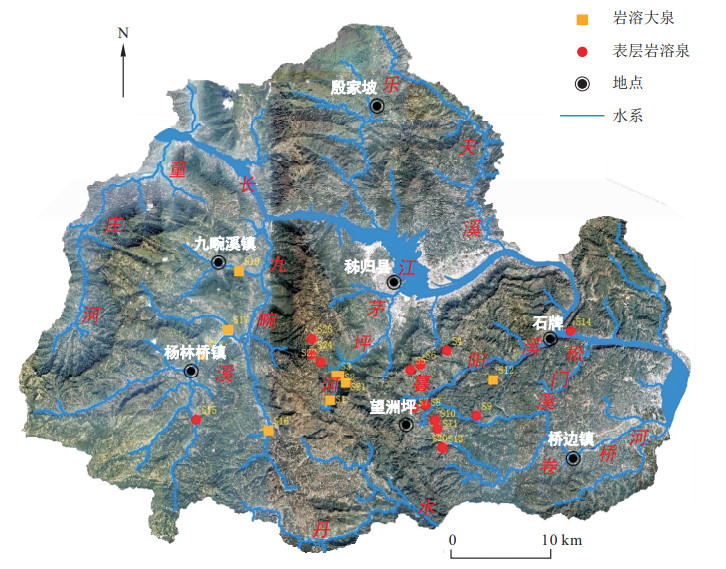Distribution of aquatic fauna in karstic groundwater and its enviro-nmental response on the south bank of the Yangtze River in Yichang
-
摘要:
为探究宜昌长江南岸岩溶区地下水中水生动物群落分布特征及环境响应规律,在2018年7月至8月对宜昌长江南岸15处表层岩溶泉及9处岩溶大泉中水生动物进行采集,同时对地下水理化指标进行测试。共采集到809个动物个体,共有13个亚纲,同时包括多个物种的暗层和非暗层种。结果发现:①不同动物在地下水空间分布上各异,在表层岩溶泉,Copepoda的暗层种和Ostracoda的暗层种大量存在(31.3%, 23.7%),Trichoptera和Diptera少量存在(0.4%, 2.9%);在岩溶大泉,Copepoda(非暗层种)和Amphipoda大量存在(25.0%, 8.3%),Ostracoda的暗层种少量存在(2.2%)。②不同地下水的环境也表现出差异,区内岩溶大泉pH, Na+, Ca2+, Mg2+等指标的极差(分别为0.64, 1.25, 34.0, 22.1 mg/L)小于表层岩溶泉(分别为2.45, 5.68, 59.6, 33.4 mg/L),表现出更稳定的环境特征。③通过对各环境因子以及不同物种的逐步回归分析得出,表层岩溶泉的主控环境因子为pH, Na+, Mg2+,岩溶大泉的主控环境因子为pH, SO42-, Mg2+;表层岩溶泉的主要代表性生物群落为Ostracoda, Diptera, Turbellaria的暗层物种,岩溶大泉的主要代表性生物群落为Mollusca, Diptera, Decapoda。④通过路径分析发现,生物通过种间相互作用,对环境因子具有直接与间接响应。在表层岩溶泉,Diptera主要通过与Ostracoda的种间关系对Na+和Mg2+起间接响应,另外Ostracoda, Diptera, Turbellaria的暗层种对pH有直接响应;在岩溶大泉,Mollusca主要通过Diptera对pH起间接响应,Diptera通过Decapoda对SO42-起间接响应,另Mollusca, Diptera, Decapoda对Mg2+直接响应。研究发现生物分布规律是对于环境因子的直接作用和生物之间的间接作用共同响应结果。
Abstract:To understand the distribution of aquatic fauna in karst groundwater and its environmental response, aquatic fauna and water samples were collected from 15 epikarst springs and 9 large karst springs on the south bank of the Yangtze River in Yichang from July to August 2018. In total, 809 individuals were collected, and they belonged to 13 subclasses. We found that: ①The spatial distribution of different animals in groundwater was different. Copepoda and Ostracoda stygobionts were abundant in epikarst springs (31.3%, 23.7%), Trichoptera and Diptera were less abundant (0.4%, 2.9%). Copepoda and Amphipoda were abundant in large springs (25.0%, 8.3%), Ostracoda stygobionts were less abundant (2.2%). ②The variation range of environmental factors (pH, Na+, Ca2+, Mg2+) in large karst springs (0.64, 1.25 mg/L, 34.0 mg/L, 22.1 mg/L) was narrower than that in epikarst springs (2.45, 5.68 mg/L, 59.6 mg/L, 33.4 mg/L), which indicated a relatively stable condition. ③According to the stepwise regression analysis, the main environmental factors of epikarst springs were pH, Na+ and Mg2+, and the main environmental factors of large karst springs were pH, SO42- and Mg2+. Moreover, the representative biological communities of epikarst springs were Ostracoda, Diptera and dark layer species of Turbellaria, and the representative biological communities of large karst springs were Mollusca, Diptera and Decapoda. ④According to the path analysis, Diptera mainly responded indirectly to Na+ and Mg2+ through Ostracoda, and Ostracoda stygobionts, Diptera and Turbellaria responded directly to pH in epikarst springs. In large karst springs, Mollusca mainly indirectly responded to pH through Diptera, Diptera indirectly responded to SO42- through Decapoda, and Mollusca, Diptera and Decapoda directly responded to Mg2+. The distribution of fauna in groundwater was the result of a direct response to environmental factors and an indirect response between different species.
-
表 1 宜昌长江南岸地区表层岩溶泉及岩溶大泉中采集到的水生动物名称及个数
Table 1. Information of aquatic fauna collected in epikarst springs and large karst springs on the south bank of the Yangtze River in Yichang
生物名称 表层岩溶泉 岩溶大泉 总数 数量 占比/% 数量 占比/% Turbellaria_s 4 0.8 0 0.0 4 Mollusca 1 0.2 1 0.3 2 Mollusca_s 11 2.3 2 0.6 13 Ephemeroptera 34 7.0 13 4.0 47 Trichoptera 2 0.4 9 2.8 11 Diptera 14 2.9 25 7.7 39 Decapoda 22 4.5 4 1.2 26 Amphipoda 52 10.7 27 8.3 79 Amphipoda_s 39 8.0 0 0.0 39 Ostracoda 11 2.3 3 0.9 14 Ostracoda_s 115 23.7 7 2.2 122 Copepoda 28 5.8 81 25.0 109 Copepoda_s 152 31.3 152 46.9 304 暗层生物数量
(非暗层生物数量)321
(164)66.2
(33.8)161
(163)49.7
(50.3)482
(327)总的个体数量 485 100 324 100 809 表 2 2018年7-8月宜昌长江南岸地区表层岩溶泉及岩溶大泉的环境因子对水生动物丰度的逐步回归分析
Table 2. Stepwise regression analysis between environmental factors and aquatic fauna abundance of epikarst springs and large karst springs on the south bank of the Yangtze River in Yichang from July to August 2018
类型 回归方程式 P* R** 决定系数*** 表层岩溶泉 NTurb_s=2.268-0.057[Mg2+]-0.246[Na+] 0.011 0.726 0.527 NAmph=17.396-0.534[Mg2+] 0.048 0.517 0.268 NOstr=-0.812+0.725[Na+] 0.014 0.616 0.379 NOstr_s=-218.914+26.179pH+0.334[Ca2+]-0.634[SO42-] 0.001 0.867 0.752 NCop_s=-9.953+0.274[NO3-]+0.526[Mg2+] 0.006 0.754 0.569 岩溶大泉 NDip=-0.354+0.192[Mg2+] 0.021 0.744 0.554 NDeca=-1.193+0.081[SO42-] 0.007 0.818 0.668 NAmph=12.949-0.254[SO42-]-0.296[Mg2+] 0.036 0.818 0.669 NOstr=12.293+0.060[Ca2+]-1.838pH 0.012 0.879 0.772 NCop=-15.047+1.191[SO42-] 0.009 0.803 0.645 NCop_s=-544.802+3.167[SO42-]+62.603pH 0.006 0.907 0.822 *P为显著性,P < 0.05为显著;**R为相关系数;***决定系数为线性回归拟合优度;NTurb_s表示Turbellaria_s的丰度,NAmph表示Amphipoda的丰度,NOstr表示Ostracoda的丰度,NOstr_s表示Ostracoda_s的丰度,NCop_s表示Copepoda_s的丰度,NDip表示Diptera的丰度,NDeca表示Decapoda的丰度,NCop表示Copepoda的丰度 表 3 2018年7-8月宜昌长江南岸地区表层岩溶泉及岩溶大泉的水生动物丰度对主控环境因子的逐步回归分析
Table 3. Stepwise regression analysis between aquatic fauna abundance and main environmental factors of epikarst springs and large karst springs on the south bank of the Yangtze River in Yichang from July to August 2018
类型 回归方程式 P* R** 决定系数*** 表层岩溶泉 pH=8.100+0.024 NOstr 0.001 0.770 0.593 [Na+]=2.011+0.693 NOstr-0.415 NDip 0.002 0.798 0.637 [Mg2+]=28.043-7.377 NTurb_s 0.022 0.586 0.343 岩溶大泉 pH=7.503+0.059 NAmph+0.064 NDip+0.086 NEph-0.285 NMol 0.003 0.983 0.966 [Mg2+]=8.279+2.877 NDip 0.021 0.744 0.554 [SO42-]=20.003+6.849 NDeca-0.953 NAmph 0.003 0.923 0.856 *P为显著性,P < 0.05为显著;**R为相关系数;***决定系数为线性回归拟合优度;NOstr表示Ostracoda的丰度,NDip表示Diptera的丰度,NTurb_s表示Turbellaria_s的丰度,NDeca表示Decapoda的丰度,NAmph表示Amphipoda的丰度,NEph表示Ephemeroptera的丰度,NMol表示Mollusca的丰度 表 4 2018年7-8月宜昌长江南岸地区表层岩溶泉和岩溶大泉的环境因子对水生动物丰度的路径分析
Table 4. Path analysis between environmental factors and aquatic fauna abundance of epikarst springs and large karst springs on the south bank of the Yangtze River in Yichang from July to August 2018
类型 环境因子 水生动物名称 相关系数 直接作用系数 间接作用系数总和 间接作用系数 →Ostr →Turb_s →Dip 表层岩溶泉 pH Ostr -0.058 -0.148 0.090 0.010 0.080 Turb_s -0.198 -0.194 -0.004 0.003 -0.007 Dip 0.220 0.234 -0.014 -0.021 0.007 Na+ Ostr 0.616 0.694 -0.078 0.012 -0.090 Turb_s -0.243 -0.221 -0.022 -0.030 0.008 Dip -0.246 -0.479 0.233 0.225 0.008 Mg2+ Ostr -0.290 -0.548 0.258 0.029 0.229 Turb_s -0.586 -0.588 0.002 0.014 -0.012 Dip 0.353 0.439 -0.086 -0.106 0.020 类型 环境因子 水生动物名称 相关系数 直接作用系数 间接作用系数总和 间接作用系数 →Ostr →Turb_s →Dip 岩溶大泉 pH Dip 0.110 0.133 -0.023 -0.011 -0.011 Deca -0.239 -0.292 0.053 0.006 0.047 Mol -0.287 -0.570 0.283 0.274 0.009 Mg+ Dip 0.744 0.717 0.027 0.011 0.016 Deca 0.217 0.242 -0.025 0.039 -0.064 Mol 0.392 0.398 -0.006 0.030 -0.036 SO42- Dip 0.059 0.024 0.035 0.143 -0.108 Deca 0.818 0.784 0.034 0.003 0.031 Mol -0.192 -0.060 -0.132 0.002 -0.134 -
[1] 靖娟利, 陈植华, 胡成, 等. 中国西南部岩溶山区生态环境脆弱性评价[J]. 地质科技情报, 2003, 32(3): 95-99, 108. https://www.cnki.com.cn/Article/CJFDTOTAL-DZKQ200303019.htmJing J L, Chen Z H, Hu C, et al. Study on eco-environment fragile evaluation of karst mountains in Southwest China[J]. Geological Science and Technology Information, 2003, 32(3): 95-99, 108 (in Chinese with English abstract). https://www.cnki.com.cn/Article/CJFDTOTAL-DZKQ200303019.htm [2] 郭芳. 岩溶洞穴交互带的环境功能特征及形成机制[D]. 西安: 长安大学, 2017.Guo F. The characteristics of environment function and formation mechanism of cave hyporheic zone in karst water system[D]. Xi'an: Chang'an University, 2017 (in Chinese with English abstract). [3] 陈静, 罗明明, 廖春来, 等. 中国岩溶湿地生态水文过程研究进展[J]. 地质科技情报, 2019, 38(6): 221-230. https://www.cnki.com.cn/Article/CJFDTOTAL-DZKQ201906027.htmChen J, Luo M M, Liao C L, et al. Review of eco-hydrological process in karst wetlands of China[J]. Geological Science and Technology Information, 2019, 38(6): 221-230 (in Chinese with English abstract). https://www.cnki.com.cn/Article/CJFDTOTAL-DZKQ201906027.htm [4] Yan Z, Li W, Shen T, et al. Aquatic microalgal and bacterial communities in a karst wetland watershed[J]. Journal of Hydrology, 2020, 591: 125573. doi: 10.1016/j.jhydrol.2020.125573 [5] D'Souza A M, Gauns M. Spatial variability of copepod species distribution in the eastern Arabian Sea in pre-monsoon conditions[J]. Deep-Sea Research, 2018, 156: 111-120. https://www.sciencedirect.com/science/article/pii/S0967064517301777 [6] 赵红亮, 郭芳, 刘绍华. 灵水岩溶泉浮游植物群落结构及其对水环境的指示作用[J]. 中国岩溶, 2017, 36(4): 484-491. https://www.cnki.com.cn/Article/CJFDTOTAL-ZGYR201704009.htmZhao H L, Guo F, Liu S H: Structure of phytoplankton community at the Lingshui karst spring and its implications for water environment[J]. Carsologica Sinica, 2017, 36(4): 484-491 (in Chinese with English abstract). https://www.cnki.com.cn/Article/CJFDTOTAL-ZGYR201704009.htm [7] 赵红亮. 武鸣盆地岩溶泉内浮游生物群落结构及其环境指示作用研究[D]. 北京: 中国地质科学院, 2017.Zhao H L. Study on the structure of plankton community andits environmental indicators of karst spring in Wuming Basin[D]. Beijing: Chinese Academy of Geological Sciences, 2017 (in Chinese with English abstract). [8] Liu W, Zhou C Y, Julia E B, et al. The effect of hydrological and hydrochemical parameters on the micro-distribution of aquatic fauna in drip water in the Velika Pasica Cave, Central Slovenia[J]. Ecohydrology. 2017, 10: e1835. doi: 10.1002/eco.1835 [9] 刘伟, 周翠英, 袁爱华, 等. 岩溶表层带水生动物研究进展[J]. 中国岩溶, 2016, 35(6): 712-719. https://www.cnki.com.cn/Article/CJFDTOTAL-ZGYR201606015.htmLiu W, Zhou C Y, Yuan A H, et al. Progress of research on aquatic fauna in epikarst[J]. Carsologica Sinica, 2016, 35(6): 712-719 (in Chinese with English abstract). https://www.cnki.com.cn/Article/CJFDTOTAL-ZGYR201606015.htm [10] 罗健. 典型表层岩溶泉域水化学特征环境敏感性及其碳汇效应: 以重庆金佛山水房泉流域为例[D]. 重庆: 西南大学, 2013.Luo J. Study on environmental susceptivity of hydrochemical variations and carbon sink effect in the typical epikarst spring: A case of Shuifang Spring area in Jinfo Mountain in Chongqing, China[D]. Chongqing: Southwest University, 2013 (in Chinese with English abstract). [11] 韦丽琼, 郭芳, 姜光辉. 广西武鸣盆地岩溶泉口浮游生物群落对水环境变化的响应[J]. 湖泊科学, 2022, 33(3): 1-15. https://www.cnki.com.cn/Article/CJFDTOTAL-FLKX202203007.htmWei L Q, Guo F, Jiang G H. Responses of plankton community to water Environment changes in karst springs in Wuming Basin, Guangxi Province[J]. Journal of Lake Sciences, 2022, 33(3): 1-15 (in Chinese with English abstract). https://www.cnki.com.cn/Article/CJFDTOTAL-FLKX202203007.htm [12] Mori N, Debeljak B, Škerjanec M, et al. Modelling the effects of multiple stressors on respiration and microbial biomass in the hyporheic zone using decision trees[J]. Water Research, 2019, 149: 9-20. [13] 刘伟, 周宏, 柯怡兵, 等. 岩溶表层带水生动物微分布规律及水文环境影响: 以Velika Pasica溶洞为例[J]. 中国岩溶, 2017, 36(4): 563-571. https://www.cnki.com.cn/Article/CJFDTOTAL-ZGYR201704019.htmLiu W, Zhou H, Ke Y B, et al. Micro-distribution of epikarstic aquifer fauna and its hydrological interpretation: A case study of Velika Pasica Cave in Slovenia[J]. Carsologica Sinica, 2017, 36(4): 563-571(in Chinese with English abstract). https://www.cnki.com.cn/Article/CJFDTOTAL-ZGYR201704019.htm [14] 吕保义, 谢建云, 郑喻, 等. 稀土尾矿库周边地下水微生物的群落多样性研究[J]. 环境工程: 2015, 33(增刊1): 101-116. https://www.cnki.com.cn/Article/CJFDTOTAL-HJGC2015S1024.htmLü B Y, Xie J Y, Zheng Y, et al. Study on microbial biodiversity in the groundwater around tailings of rare earth[J]. Environmental Engineering, 2015, 33(S1): 101-116 (in Chinese with English abstract). https://www.cnki.com.cn/Article/CJFDTOTAL-HJGC2015S1024.htm [15] 朱玉, 王德利, 钟志伟. 生态系统基于性状调节的物种间接作用: 特征、成因及后果[J]. 生态学报, 2017, 37(23): 7781-7790. https://www.cnki.com.cn/Article/CJFDTOTAL-STXB201723003.htmZhu Y, Wang D L, Zhong Z W: Characteristics, causes, and consequences of trait-mediated indirect interactions in eco-systems[J]. Acta Ecologica Sinica, 2017, 37(23): 7781-7790 (in Chinese with English abstract). https://www.cnki.com.cn/Article/CJFDTOTAL-STXB201723003.htm [16] 沈嘉瑞. 中国动物志: 节肢动物门甲壳纲淡水桡足类[M]. 北京: 科学出版社, 1979.Shen J R. Faunasinica: Arthropoda crustacea freshwater copepoda[M]. Beijing: Science Press, 1979 (in Chinese). [17] Hunt P V, Brian P V C, François D, et al. Trophic pathways of phytoplankton size classes through the zooplankton food web over the spring transition period in the North-West Mediterranean Sea[J]. Journal of Geophysical Research: Solid Earth, 2017, 122(8): 6309-6324. doi: 10.1002/2016JC012658 [18] Mori N, Brancelj A. Distribution and habitat preferences of species within the genus Elaphoidella Chappuis, 1929 (Crustacea: Copepoda: Harpacticoida) in Slovenia[J]. Zoologischer Anzeiger, 2007, 247(2): 85-94. https://www.sciencedirect.com/science/article/pii/S0044523108000065 [19] Brancelj A, Žibrat U, Jamnik B. Differences between groundwater fauna in shallow and in deep intergranular aquifers as an indication of different characteristics of habitats and hydraulic connections[J]. Journal of Limnology, 2016, 75(2): 248-261. [20] Slabe M, Danevcic T, Hug K, et al. Key drivers of microbial abundance, activity, and diversity in karst spring waters across an altitudinal gradient in Slovenia[J]. Aquatic Microbial Ecology, 2021, 86: 99-114. [21] Basu S, Gogoi P, Bhattacharyya S, et al. Variability in the zooplankton assemblages in relation to environmental variables in the tidal creeks of Sundarbans Estuarine System, India[J]. Environmental Science and Pollution Research, 2022, 29(30): 45981-46002. [22] Thomas B, Christopher S, Thomas J, et al. Aligning indicators of community composition and biogeochemical function in stream monitoring and ecological assessments[J]. Ecological Indicators, 2016, 60: 970-979. https://www.sciencedirect.com/science/article/pii/S1470160X15004811 [23] Larson D M, DeJong D, Anteau M J, et al. High abundance of a single taxon (amphipods) predicts aquatic macrophyte biodiversity in Prairie Wetlands[J]. Biodiversity and Conservation, 2022, 31(3): 1073-1093. [24] Heneash A M, Alprol A E, El-Naggar H A, et al. Multivariate analysis of plankton variability and water pollution in two highly dynamic sites, southeastern Mediterranean (Egyptian Coast)[J]. Arabian Journal of Geosciences, 2022, 15(4): 330-352. [25] Li Y, Geng M D, Yu J L, et al. Eutrophication decrease compositional dissimilarity in freshwater plankton communities[J]. Science of the Total Environment, 2022, 821: 153434. [26] Dza B, Mh B, Ac B, et al. Sulphate in freshwater ecosystems: A review of sources, biogeochemical cycles, ecotoxicological effects and bioremediation[J]. Earth-Science Reviews, 2020, 212: 103446. [27] Eysteinsson S T, Arason S, Gujónsdóttir M. Chemical characterization and processing suitability of zooplankton-rich side-streams from Atlantic Mackerel (Scomber scombrus) processing[J]. Journal of Food Composition and Analysis, 2020, 89: 103471. https://www.sciencedirect.com/science/article/pii/S0889157519316242 [28] Shaikhutdinov N, Gusev O. Chironomid midges (Diptera) provide insights into genome evolution in extreme environments[J]. Current Opinion in Insect Science, 2022, 49: 101-107. [29] Ewald M L, Feminella J W, Lenertz K K, et al. Acutephysiological responses of the freshwater snail Elimia Flava (Mollusca: Pleuroceridae) to environmental pH and Calcium[J]. Comparative Biochemistry and Physiology: Toxicology & Pharmacology, 2009, 150(2): 237-245. https://www.sciencedirect.com/science/article/pii/S1532045609001124 [30] Qiang G, Liu J, Batzer D P, et al. Snails (Mollusca: Gastropoda) aspotential surrogates of overall aquatic invertebrate assemblage in Wetlands of Northeastern China[J]. Ecological Indicators, 2018, 90: 193-200. https://www.sciencedirect.com/science/article/pii/S1470160X18300761 [31] Carlos I, Julio P, Dario A. Selection of macroinvertebrate metrics for rapid assessment of the human impact by biotic conditions of Bolivian Altiplano streams[J]. Journal of South American Earth Sciences, 2022, 113(1): 103638. https://www.sciencedirect.com/science/article/pii/S0075951113000133 [32] Leclercq-Dransart J, Demuynck S, Bidar G, et al. Does adding fly ash to metal-contaminated soils play a role in soil functionality regarding metal availability, litter quality, microbial activity and the community structure of Diptera larvae?[J]. Applied Soil Ecology, 2019, 138(3): 99-111. -





 下载:
下载:





